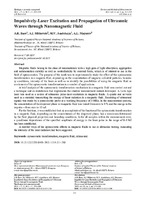Impulsively-Laser Excitation and Propagation of Ultrasonic Waves through Nanomagnetic Fluid

Date
2021Publisher
Another Title
Импульсно-лазерное возбуждение и прохождение ультразвуковых волн через наномагнитную жидкость
Bibliographic entry
Impulsively-Laser Excitation and Propagation of Ultrasonic Waves through Nanomagnetic Fluid = Импульсно-лазерное возбуждение и прохождение ультразвуковых волн через наномагнитную жидкость / A. R. Baev [et al.] // Приборы и методы измерений. – 2021. – Т. 12, № 3. – С. 211-219.
Abstract
Magnetic fluids belong to the class of nanomaterials with a high gain of light absorption, aggregative and sedimentation stability as well as controllability by external fields, which is of interest to use in the field of optoacoustics. The purpose of the work was to experimentally study the effect of the optoacoustic transformation in a magnetic fluid, depending on the concentration of magnetic colloidal particles, boundary conditions, intensity of the laser as well as to identify the possibilities of using the magnetic fluid as an element of the optoacoustic transformation in a number of applications. A brief analysis of the optoacoustic transformation mechanism in a magnetic fluid was carried out and a technique and an installation that implements the shadow measurement variant developed. A Lotis type laser was used as a source of ultrasonic pulse-laser excitation in magnetic fluids. A quartz and air were used as a material transmitting the energy of laser radiation in a magnetic fluid. Receiving of ultrasound signals was made by a piezoelectric probe at a working frequency of 5 MHz. In the measurement process, the concentration of the dispersed phase in tmagnetic fluid was varied from zero to 8 % and the energy in the impulse – from zero to 10 mJ. For the first time, it was established that: a) an amplitude of the function of the optoacoustic transformation in a magnetic fluid, depending on the concentration of the dispersed phase, has a maximum determined by the fluid physical properties and boundary conditions; b) for all samples within the measurement error, a quasilinear dependence of the specified amplitude of energy in the laser pulse in the range of 0–8 MJ has been established. A number ways of the optoacoustic effects in magnetic fluids to use in ultrasonic testing, measuring the intensity of the laser radiation had been suggested.
Abstract in another language
Магнитные жидкости относятся к классу наноматериалов, обладающих высоким коэффициентом поглощения света, агрегативной и седиментационной устойчивостью, а также управляемостью внешними полями, что представляет интерес для использования в области оптоакустики. Цель работы состояла в экспериментальном исследовании эффекта оптоакустического преобразования в магнитной жидкости в зависимости от концентрации дисперсной фазы и способа воздействия на неё лазерного излучения, а также выявления возможностей использования магнитной жидкости в качестве элемента оптоакустического преобразования в ряде приложений. Проведён краткий анализ механизма оптоакустического преобразования в магнитной жидкости и разработана методика и установка, реализующая теневой вариант измерений, где в качестве источника импульсно-лазерного воздействия на магнитную жидкость использован лазер типа Lotis. В качестве материала световода, передающего энергию лазерного излучения в магнитной жидкости, использованы кварц и воздух. Приём ультразвуковых сигналов производился пьезопреобразователем на рабочей частоте 5 МГц. В процессе измерений варьировалась концентрация дисперсной фазы в магнитной жидкости (0–8 %) и энергия в импульсе (0–10 мДж). Впервые установлено, что: а) амплитуда функции оптоакустического преобразования в магнитной жидкости в зависимости от концентрации дисперсной фазы, имеет максимум, величина и положение которого на оси концентраций определяется свойствами световода; б) для всех образцов в пределах погрешности измерений установлена квазилинейная зависимость указанной амплитуды от энергии в импульсе в диапазоне 0–8 мДж. Предложен ряд схемных решений использования эффекта оптоакустического преобразования в магнитной жидкости для ввода сигнала в исследуемые объекты – применительно к их дефектоскопии и структуроскопии, а также для решения обратной задачи – измерения интенсивности лазерного излучения.
View/
Collections
- Т. 12, № 3[12]
